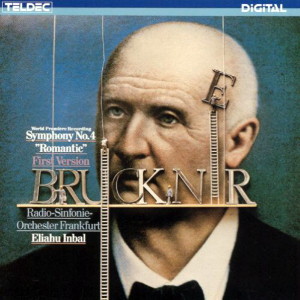 |
|
1 LP -
6.42921 AZ - (p) 1983
|
 |
| 1 CD -
8.42921 ZK - (c) 1984 |
|
| ANTON BRUCKNER
(1824-1896) |
|
|
|
|
|
| Symphonie
Nr. 4 Es-dur "Romantische" -
Erstfassung 1874 |
68'
14"
|
|
| -
Allegro |
18' 53" |
|
| -
Andante quasi allegretto |
18' 42" |
|
| -
Sehr schnell · Trio: Im gleichen
Tempo |
13' 11" |
|
-
Allegro moderato
|
17' 18" |
|
|
|
|
| Radio-Sinfonie-Orchester
Frankfurt |
|
| Elihau Inbal,
Leitung |
|
|
|
|
|
Luogo
e data di registrazione |
|
Frankfurt
(Germania) - settembre 1982
|
|
|
Registrazione:
live / studio |
|
studio |
|
|
Producer /
Engineer |
|
- |
|
|
Prima Edizione LP |
|
Teldec
- 6.42921 AZ - (1 LP) - durata 68'
14" - (p) 1983 - Digitale |
|
|
Prima Edizione CD |
|
Teldec
- 8.42921 ZK - (1 CD) - durata 68'
14" - (c) 1984 - DDD |
|
|
Note |
|
Coproduktion
mit dem HR.
|
|
|
|
|
Bruckner’s
Fourht Symphony, drafted in
1874 and rewritten a total
of three times, is possibly
his most popular work.
Despite verbal comments made
by Bruckner’s
contemporaries, which point
to the existence of various
programmes for the symphony,
we have no concrete evidence
that a programmatic
portrayal of nature was
intended.
Notwithstanding, the work
must have concerned itself
with the subject of nature
at least in parody fashion,
since the epithet
”Romantic“, which Bruckner
himself added to the
manuscript, had associations
with nature in contemporary
linguistic usage. The
hunting scherzo, which was
substituted for the original
scherzo in the second
version of the symphony,
likewise alludes to this
topic. The musical proof,
however, lies in the horn
theme of the first movement,
that grows out of a soft
tonal shadow originating
from nothingness, and
possesses the traditional
hunting-call character. Here
Bruckner - comparable to
Weber in the ”Freischütz“
Overture - builds up an
atmosphere of nature without
lapsing into a process of
descriptive imitation.
The first version of the
symphony characterised by
the keywords periodicity,
punctuation, dynamic impact
contrasts, antipodean
woodwind writing, an
(inaudible) wealth
of information and a logical
structuring of the thematic
material. If the first
movement thereby presents
the antithesis as a pattern
of genesis and development,
the second movement reacts
to the association matrix of
its predecessor. Aveiled
funeral march with no less
than ten different tempo
markings and interspersed
chorale passages aims at
forcefulness,
intensification and
reinforcement. Where in the
second version of the
scherzo it is the harmonic
traversing of chords that
parodies the sound of the
hunting horns, the motif of
the first version is
depicted as a jump-and-step
model based on fifths with
expanded movement into
fourths and sixths. This
tension of seconds, already
formulated by Beethoven,
appears in the oscillating
suspension of violin trills
in the meanings of the
chromatic structures,
whereby compact blocks are
set in relief against the
solo horn. It is certainly
no mere coincidence that the
trio melody works with the
same material, analogically
speaking, with tremolo
strings and planes of a
fifth, fourth and sixth in
the oboes. Here, more
clearly than elsewhere,
Bruckner’s technique of
inverting characteristic
final intervals is shown in
all but didactic form.
The final brings together
the main structural elements
of the preceding movements
once more. Although there is
not much to distinguish it
from the second version in
terms of basic thematic
material, Bruckner achieves
a construction principle,
with the aid of differently
sequenced stages of
development, that is
redolent of the third
movement in its
counter-rotating violin line
coloured by thirds, of the
main subject of the first
movement in its
soloistically accentuated
bass ostinato. Just how
important the rhythmic
dovetailings were to
Bruckner can be deduced from
the extremely precise
notation, which must have
required considerable
expenditure of time, so that
one can assume that the
composer devoted his
complete concentration to
it. A tonal check on the
written material soon
demonstrates the conceptual
potential that Bruckner
wanted to realise with the
help of this complex
notation: in part physically
masked resonant and
anticipatory sounds,
suspensions, oscillations
that provide evidence of
Bruckner’s fanatical
preoccupation with
exactness: the intellectual
aspects of his music can
only be broughtout in
performance by the
realisation of these
phenomena. The former gentle
qualities of the movements
are pressed together here in
a restricted space, thrust
up against each other,
placed on top of one
another, and stand in model
form, as it were, for
Bruckner’s tendency to
develop a part into a whole,
related to each other in the
synoptic presentation of
melodic and rhythmic
substance and dinected
towards the central goal of
romantic, natural and
landscape associations.
Manfred
Wagner
Translation:
Clive R. Williams
|
|
|